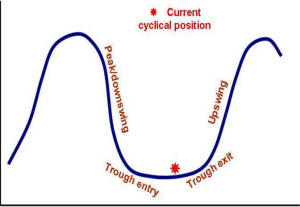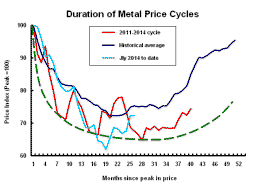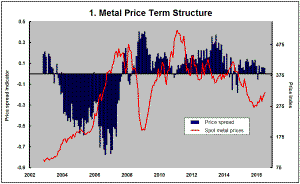The Current View
Growth in demand for raw materials peaked in late 2010. Since then, supply growth has continued to outstrip demand leading to inventory rebuilding or spare production capacity. With the risk of shortages greatly reduced, prices have lost their risk premia and are tending toward marginal production costs to rebalance markets.
To move to the next phase of the cycle, an acceleration in global output growth will be required to boost raw material demand by enough to stabilise metal inventories or utilise excess capacity.
The PortfolioDirect cyclical
guideposts suggest that the best possible macroeconomic circumstances for
the resources sector will involve a sequence of upward revisions to
global growth forecasts, the term structure of metal prices once again
reflecting rising near term shortages, a weakening US dollar, strong money
supply growth rates and positive Chinese growth momentum. Only one of
the five guideposts is "set to green" suggesting the sector remains confined
to the bottom of the cycle .

Has Anything Changed? - Updated View
Since mid 2014, the metal market cyclical position has been characterised as ‘Trough Entry’ as prices have remained in downtrend with all but one of the PortfolioDirect cyclical guideposts - the international policy stance - flashing ‘red’ to indicate the absence of support.
The absence of a global growth acceleration, a stronger dollar and flagging Chinese growth momentum remain critical features of the current cyclical positioning.
Through February 2016, the first signs of cyclical improvement in nearly two years started to emerge. After 15 months of contango, the metal price term structure shifted to backwardation reflecting some moderate tightening in market conditions.
The metal price term structure is the most sensitive of the five cyclical guideposts to short term conditions and could, consequently, quickly reverse direction. Nonetheless, this is an improvement in market conditions and the guidepost indicator has been upgraded to ‘amber’ pending confirmation of further movement in this direction.
Cyclical Improvements in Coal Prices
Mining commodity prices have generally improved since the beginning of 2016.
The improved prices reflect some re-balancing of markets but, more importantly, recognition of a more benign economic environment than had been feared in the latter part of 2015.
The economic backdrop could change rapidly once again as latent risks resurface but, at least for the time being, investors have become more risk tolerant.
Many asset markets show evidence of an improved risk appetite. Inflows of capital to emerging market funds, rising prices for high yield corporate bonds and a rebound in the prices of biotech and mining early stage companies are some of the indicators.
Put in the context of the broad sweep of history, recent
rises in thermal coal prices may not appear material but the 25% gain in
prices of coal shipped from Newcastle during 2016 has eased some of the
industry’s pain.
The early stages of a market rebalancing have been fostered by production cuts in China.
The pressure on western producers to cut back coal production so as to reduce global carbon dioxide emissions remains intense and will continue to detrimentally affect investor appetite for the sector.
The International Energy Agency attributed the dramatic cut in its coal demand forecasts contained in the 2015 annual coal report to falling demand in China as its economy is restructured and as pressure to reduce carbon emissions also intensifies.
The IEA which is now forecasting 5-year growth in demand for coal at just 0.8% a year, questioned whether the price would ever recover.
The cut in Chinese demand is now being offset, at least in part, by an adjustment on the supply side.
In steelmaking, China plans to close 45 million tonnes of capacity. Coal production is expected to be lowered by 250 million tonnes of which two-thirds of the adjustment is still to occur, according to reports from the country’s National Development and Reform Commission.
Weighting the most recent experience too heavily is always a temptation in preparing forecasts. And, just as economists once thought that double digit bond yields had become permanent, they now risk underestimating how sensitive commodity prices can be to even minor changes in market balances around the trough of a cycle.
Coal is just one example of the bottom of the cycle leverage available within the resources sector with sometimes outstanding returns in some of the least fashionable parts of the market.






